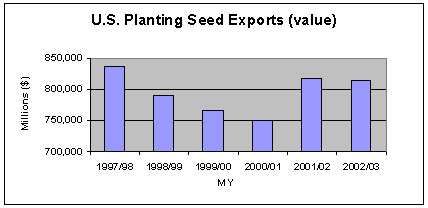September, 2003
 According
to U.S. trade statistics, the U.S. planting seed exports appear to
have fallen slightly from $818,000 million in MY 2001/02 to just
under $813,000 million in MY 2002/03. Field crop seeds, such as
corn and soybean seeds brought down the total, declining 15 percent
while grass seeds, other forage seeds, and leguminous vegetable
seeds increased 26, 24, and 18 percent, respectively. However, due
to a possible data misclassification of soybean seed exports to
Mexico in MY 2001/02, seed exports in 02/03 have actually increased
slightly. Despite the likelihood of rapid commercialization in the
Mexican soybean seed market, it appears there may be an error in
U.S. trade statistics. Currently, the Census Bureau is
investigating this data discrepancy.
According
to U.S. trade statistics, the U.S. planting seed exports appear to
have fallen slightly from $818,000 million in MY 2001/02 to just
under $813,000 million in MY 2002/03. Field crop seeds, such as
corn and soybean seeds brought down the total, declining 15 percent
while grass seeds, other forage seeds, and leguminous vegetable
seeds increased 26, 24, and 18 percent, respectively. However, due
to a possible data misclassification of soybean seed exports to
Mexico in MY 2001/02, seed exports in 02/03 have actually increased
slightly. Despite the likelihood of rapid commercialization in the
Mexican soybean seed market, it appears there may be an error in
U.S. trade statistics. Currently, the Census Bureau is
investigating this data discrepancy.
 The
value of seed exports to Western Hemisphere countries is down 11
percent while exports to the European Union, Middle East and South
Asia helped offset this decline. Exports to Mexico, our single
largest market, were down 13 percent, mostly due to an 80 percent
drop in yellow corn seeds. Seed exports to Canada declined 5
percent in large part due to a drop in other corn seed exports.
Grass seed exports to Canada increased, however. Argentina,
Italy, Japan, and Venezuela also imported less U.S. seed than last
year. Argentina decreased its alfalfa seed imports while Italy and
Venezuela decreased yellow seed corn imports. Many countries
including China, Costa Rica, France, Hong Kong, the Netherlands,
Pakistan, Saudi Arabia, and Spain all increased U.S. planting seed
imports. France, Pakistan and Spain primarily increased their
imports of yellow seed corn while China and Saudi Arabia increased
alfalfa seed imports. Hong Kong increased its imports of oat
seeds.
The
value of seed exports to Western Hemisphere countries is down 11
percent while exports to the European Union, Middle East and South
Asia helped offset this decline. Exports to Mexico, our single
largest market, were down 13 percent, mostly due to an 80 percent
drop in yellow corn seeds. Seed exports to Canada declined 5
percent in large part due to a drop in other corn seed exports.
Grass seed exports to Canada increased, however. Argentina,
Italy, Japan, and Venezuela also imported less U.S. seed than last
year. Argentina decreased its alfalfa seed imports while Italy and
Venezuela decreased yellow seed corn imports. Many countries
including China, Costa Rica, France, Hong Kong, the Netherlands,
Pakistan, Saudi Arabia, and Spain all increased U.S. planting seed
imports. France, Pakistan and Spain primarily increased their
imports of yellow seed corn while China and Saudi Arabia increased
alfalfa seed imports. Hong Kong increased its imports of oat
seeds.
U.S. planting seed imports increased 2 percent
in MY 2002/03 led by a 6 percent increase in field crop seeds and a
12 percent increase in other vegetable seed. Leguminous vegetable
seed, grass seeds and other seeds declined. The overall trend in
planting seed imports has remained relatively constant.